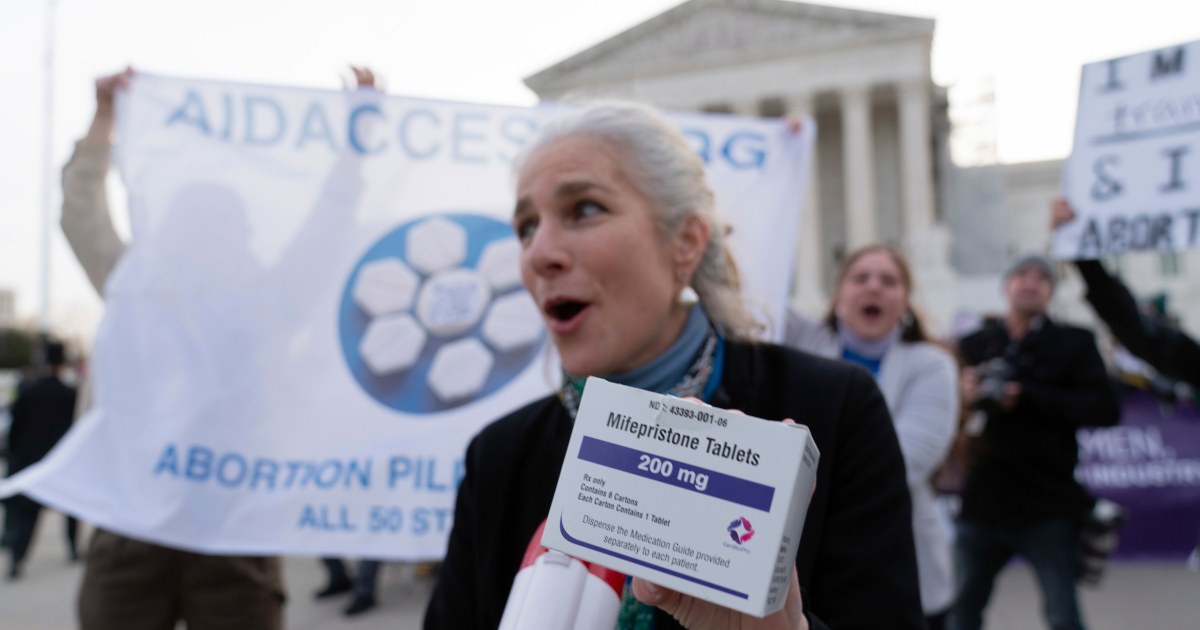Since Richard Nixon, no US president has had the opportunity to appoint three Supreme Court justices in his first term until Donald Trump.
He was able to do it thanks to the maneuvering of the Republicans in Congress.
The election of conservative judges has borne fruit.
The high court has closed this week a judicial year that has left controversial rulings on abortion, climate change, firearms, religion in schools, mandatory vaccination of workers against covid, the role of federal agencies and immigration, among other issues.
With a clear conservative majority, the Supreme Court shaped by Trump is setting the political agenda of President Joe Biden.
It's just the beginning.
In the next judicial year there will be a new face on the court, Ketanji Brown Jackson, the first black justice of the Supreme Court, but the balance of forces does not change.
The judges have already announced that they will rule on cases questioning affirmative action against minorities in access to college, the power of state legislatures — controlled mostly by Republicans — to set electoral rules above the criteria of the courts or the possibility of discriminating against homosexual couples alleging religious reasons, among many others.
In the medium term, there are threats to gay marriage or the use of contraceptives.
Apparently, the turn to the right has only just begun.
Outraged Democrats call for a forceful, and in some cases somewhat extreme, response.
“First on guns, then on abortion, and now on the environment.
This regressive and extremist MAGA [referring to Trump's motto, Make America Great Again] Supreme Court is determined to set America back decades, if not centuries," said Chuck Schumer, leader of the Senate Democrats this week. , it's a statement.
Referring to the appointment of Amy Coney Barrett to the Supreme Court, Trump's third and last, Linda Greenhouse wrote in her book
Justice on the Brink
: "It was the culmination of a project begun years earlier, which he had set out on a carefully planned path, cared for and exposed for all to see, except, of course, that most people did not look, or, if they did, they mistook occasional setbacks for lasting defeat.
It was a project to recover the Supreme Court” by the conservatives.
Despite the fact that the Republicans have only won the popular vote in a presidential election since 1992 (those of 2004 with George W. Bush), the Supreme Court has six conservative justices for three progressives.
Some Democrats believe that the Republicans have "stolen" two appointments from them.
When conservative Justice Antonin Scalia died in February 2016, Senate Republican Leader Mitch McConnell was quick to warn that he would not allow then-President Barack Obama to name his replacement.
Obama proposed Merrick Garland, a moderate judge, but there was no way.
"The American people must have a voice in the selection of the next Supreme Court justice," McConnell said then, who demanded to wait until after the November elections of that year and the inauguration of the new president,
After winning the election, Trump chose conservative Neil Gorsuch, who is now 54 years old.
The Democrats tried to pay with the same coin and block the vote in the Senate - the well-known filibuster -, as the Republicans had done with Garland.
But Mitch McConnell resorted to the so-called “nuclear option”, changing the rules of the game, and Gorsuch was ratified by 54 votes to 45 (by a simple majority).
The relationship of forces did not change in court, as one conservative replaced another.
The balance began to tip with Trump's second appointment.
The moderate judge Anthony Kennedy, who voted on some occasions with the four conservatives and on others with the four progressives, decided to retire and the person appointed to replace him was Brett Kavanaugh, who is now 57 years old, more ideologically marked.
Judge Brett Kavanaugh's swearing-in ceremony in front of his family and then-President Donald Trump in Washington in October 2018. Chip Somodevilla (Getty Images)
The total turnaround occurred with the death from cancer of the legendary progressive judge Ruth Bader Ginsburg on September 18, 2020, just a few weeks before the presidential elections that pitted Trump against Biden.
Despite her blockade four years earlier, the Republicans did not hesitate to appoint her replacement, the fervent Catholic Amy Coney Barrett (50 years old), who was ratified by the Senate just a week before the presidential elections.
With this, the most conservative Supreme Court in decades was cemented, ready for the turn to the right of the recent sentences.
In 14 sentences of the last judicial year, including many of the most important, ideological polarization has caused votes of six to three in favor of the conservative bloc.
George Washington chose the first Supreme Court justices in 1789 on geographical grounds, according to Bernard Schwartz in
A History of the Supreme Court.
The practice that has become habitual is to select them for ideological reasons.
Appointing Supreme Court judges is one of the most important powers that a president has.
Their position is for life, unless they decide to retire or are removed in a process in the Senate
(impeachment).
The conservative majority on the Supreme Court is guaranteed for many years, perhaps decades.
The oldest Conservative justices are Clarence Thomas, 74, and Samuel Alito, 72.
For Democrats, the situation is frustrating.
Some look for a way to recover the “stolen” posts.
One of the most aggressive has been New York congresswoman Alexandria Ocasio-Cortez.
She has called for the
impeachment
of some of the new judges for "lying under oath."
Ocasio-Cortez and other Democrats argue that when they appeared before the Senate to be ratified, Gorsuch and Kavanaugh called abortion a settled issue and stressed the importance of precedent in making Supreme Court decisions.
They did not make an explicit promise to uphold the
Roe v. Wade doctrine,
the 1973 ruling that established the constitutional right to abortion, now abolished, but they referred to the matter as res judicata, with "precedent upon precedent."
Another proposal that has been aired by prominent Democrats such as Senator Elizabeth Warren is the possibility of expanding the Supreme Court, which now consists of nine members, including its president.
Article III of the United States Constitution does not determine its composition.
The Supreme began its journey in New York, then the capital, at the beginning of 1790 with six members.
It changed its size several times throughout the 19th century until the judicial law of 1869 fixed it at nine, a dimension that has remained for more than a century and a half.
Democrat Franklin D. Roosevelt tried to expand it in 1937 and was roundly opposed, even within his own party.
Some Democratic congressmen introduced a bill in April 2021 to increase its size to 13 members, but the Democratic speaker of the House of Representatives herself,
Nancy Pelosi refused to take the proposal to the plenary.
Joe Biden himself rejects that shortcut.
“That is something that the president does not agree with.
It is not something he wants to do,” White House spokeswoman Karine Jean-Pierre said this week.
Biden does seem willing to take another shortcut, the so-called "nuclear option," at least with abortion.
In the United States, a simple majority is needed to pass a law, both in the Senate and in the House of Representatives.
But in the upper house, for it to be put to a vote, 60 of the 100 votes are needed, so in practice that has become the majority to pass a law - the Senate is now divided, with 50 Republicans and another 50 Democrats , plus the tiebreaker vote of the vice president, Kamala Harris.
Filibusterism was initially active: the debate dragged on with marathon sessions, as James Stewart immortalized in Frank Capra's classic
Knight Without a Sword
.
But then it has become passive and 41 senators are enough to prevent a law from being put to the vote.
That is the rule that Mitch McConnell changed for the confirmation of judges proposed by Trump, but the "nuclear option" has never been used to pass a law.
Democrats are willing to do it.
“We have to change that decision by passing
Roe v. Wade
into law.
The way to do it is by voting in Congress.
If filibustering gets in the way, we should provide an exception,” Biden said Thursday in Madrid after the NATO Summit.
Biden and Judge Ketanji Brown Jackson after the Senate vote on April 7 that confirmed his nomination.
Susan Walsh (AP)
The president has also promised to study a response to the ruling that cuts the powers of the Environmental Protection Agency (EPA) to limit greenhouse gas emissions.
Until another law is approved, the EPA cannot establish a general regulation for the entire country and the Supreme Court will have the last word on which limits exceed its powers and which do not.
“The court names itself, rather than Congress or the expert agency, as responsible for climate policy.
I can't think of many more terrifying things, ”said the progressive judges in their dissenting opinion.
Not even the "nuclear option" is within Biden's reach.
A bill was already defeated in April in the Senate by 49 votes to 51. "We need two more votes," the president admitted this Friday.
With their popularity on the floor due to high inflation, the Democrats risk losing control of both the Senate (of which a third is renewed) and the House of Representatives (which is elected in its entirety) in the mid-term legislative elections , celebrated on November 8.
The Democrat tries to turn abortion into an electoral trick.
The recent ruling that allows carrying firearms in public also tarnishes the timid advance in regulation achieved through a pact in Congress between Democrats and some Republicans.
And it begins to have repercussions.
New York has passed a new law limiting guns on public transportation and large crowds.
But a lawsuit has already been filed in Washington demanding the right to carry weapons on the subway or bus, alleging that the ban on doing so is unconstitutional.
Conservative justices consider themselves originalists, faithful to the letter of the Constitution.
This leads them to ignore or leave in the air rights that have been consolidated later, many thanks to the Supreme Court itself.
That hasn't stopped them, instead, from blowing a hole in the “separation wall” between Church and State that President Thomas Jefferson referred to in 1802 when announcing the First Amendment.
Scholarships to attend religious schools in Maine or support for the coach of a state school team to pray after games on the court mean breaking down that wall, according to progressive magistrates.
Conservative judges are prone to strip power from the federal government.
But while they have repealed the constitutional right to abortion, arguing that it is up to the States to decide, at the same time they have declared the constitutional right to bear arms in public, ruling that the States should not be left to decide.
State choice is sometimes dysfunctional in American politics.
Gerrymandering,
the
design of custom rigged electoral districts, distorts representation in state legislatures (also in the House of Representatives, though to a lesser degree).
In Wisconsin, in the last legislative elections, the Democrats achieved a clear majority of votes, 53%, but the Republicans, with 45%, took 61 of the 99 seats in the state Assembly.
This phenomenon tends to perpetuate itself and the only way to block the laws is for the governor, who is elected by popular vote, to veto them.
The rulings of the high court are fueling the polarization and division of the country between States with very different laws and rights.
All of this deteriorates the quality of American democracy.
Meanwhile, a Gallup poll shows that both the percentage of Americans who approve of the Supreme Court's discharge and those who trust the institution a great deal or quite a bit have plunged.
Confidence has fallen to 25%, 15 points in two years, since Trump's last appointment.
It is at the historical minimum of a series that starts in 1973, just the year of
Roe against Wade.
Follow all the international information on
and
, or in
our weekly newsletter
.
50% off
Exclusive content for subscribers
read without limits
subscribe
I'm already a subscriber





/cloudfront-eu-central-1.images.arcpublishing.com/prisa/OV2VBR4SENF6HBYT4PL7REJMVU.jpg)



